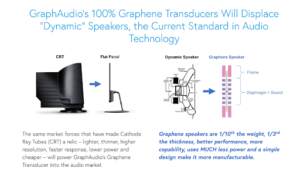August 26, 2021
Just as clunky cathode ray tube televisions were displaced in the 1980s by flat panel, vivid displays, today’s audio technology may soon be displaced by graphene-based audio tech.
In 2014, principal investigator Alex Zettl and postdoctoral researcher Qin Zhou of Berkeley Lab and the University of California at Berkeley published a seminal paper about their invention that used graphene as a robust electrostatic speaker diaphragm material.
The inventors had created a sound transducer, using several layers of graphene film that converts electrical signals into sound. In some popular in-ear headphones, only about 10 percent of electrical energy is converted to sound while the rest is lost as heat. The new graphene transducer converted about 99 percent by comparison. In addition, the transducers had no audio distortion, ran on much lower power, had better form factors, and weighed much less than the vast majority of current speaker technology.
Such an invention could transform a variety of devices including speakers, earbuds and headphones, microphones, autonomous vehicle sensors, and ultrasonic and echolocation systems. Thin car speakers, for example, could be embedded in a vehicle’s interior ceiling for an improved surround-sound experience. Improved car sensors that rely on two-way echolocation could help avoid vehicle collisions. The air-damped graphene was also highly energy efficient, a characteristic that is advantageous for mobile devices (such as earphones) in which energy consumption is crucial.
For more information, see “A Graphene Innovation That is Music to Your Ears,” March 11, 2020, Berkeley Lab Newscenter.
GraphAudio, a California-based company, snapped up a license to this technology in 2016, with a plan to develop graphene components in earbud headphones and amplifiers that would be integrated into products made by established audio-product manufacturers. By 2017, GraphAudio had developed graphene transducers that could play music. In 2020, GraphAudio demonstrated the world’s first pure graphene speakers at the Consumer Electronics Show (CES), to high acclaim.
“Qin Zhou and A. Zettl of the University of California at Berkeley realized the newly discovered material graphene could make a great electrostatic [diaphragm] material…
…Thin, conductive, and strong with a high spring constant, graphene could prove to be the material diaphragms of the future are made of, not gel. Due to the combination of properties, graphene speakers could be several magnitudes more energy efficient than current speaker design, leading to some great new applications.”
— The HeadPhoneList.com 1/16/14
The first consumer products are expected to reach the market in one or two years. In a Dot.la article, chief executive Ramesh Ramchandani states, “We want to bring an audiophile experience to the mass market and become the ‘Intel Inside’ of audio.”
Additionally, the Berkeley Lab/UC Berkeley research team is exploring ways to make new types of mechanical transducers with ultrathin materials that are manufactured with tunable elastic properties – enabled by precisely patterned nanoscale holes or slots. In conjunction with their use in new transducer configurations, such perforated membranes could also be useful for applications ranging from water filtration to genetic sequencing.
“To be able to work on things that have real applications and public benefits – it’s nice to see that full progression,” co-inventor Alex Zettl says. “I’m thrilled to be able to see these applications come out of this. For me that’s personally rewarding.”
Additional Information:
-
- Berkeley Lab news article: https://newscenter.lbl.gov/2020/03/11/graphene-innovation-music-to-your-ears/
- The Affordable Audiophile article: https://insights.globalspec.com/article/6507/the-affordable-audiophile


